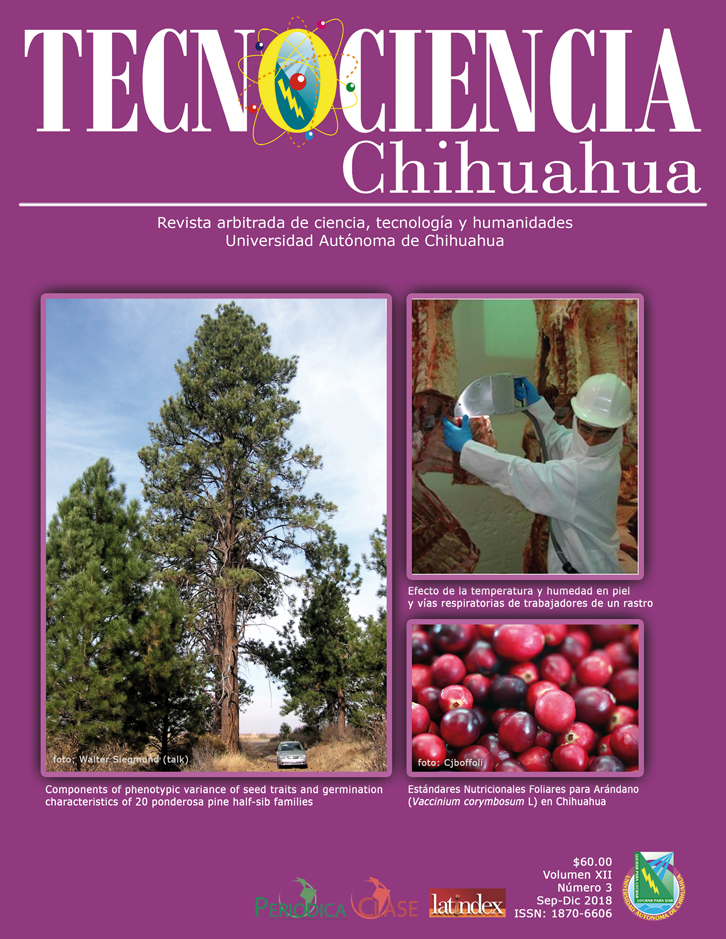¿Qué relación existe entre la calidad aromática del vino y la bioquímica de la vid?
What is the relationship between the aromatic quality of the wine and the biochemistry of the vine?
Resumen
Cada una de las biomoléculas sintetizadas a través de distintas rutas del metabolismo primario de la vid, es capaz de formar metabolitos secundarios, como los compuestos aromáticos o volátiles. Actualmente se conocen las rutas de β-oxidación, lipooxigenasa y vía isoprenoide para los compuestos aromáticos provenientes de los lípidos, sin embargo, la vía isoprenoide también proviene a partir de la intervención de los carbohidratos. Los aminoácidos leucina, isoleucina, triptófano, metionina, cisteína y fenilalanina inducen a la síntesis de diversos compuestos aromáticos en frutas, como precursores directos o indirectos. A pesar de que existen estudios de los compuestos aromáticos en frutas, en uva para vino pudiera ser de mayor complejidad, ya que las uvas pueden desarrollar distintos tipos de compuestos aromáticos, dependiendo de la variedad, manejo agronómico y factores edafo-climáticos. Por lo que el objetivo de la presente revisión es resaltar la relación existente entre la calidad aromática del vino y la bioquímica de la vid, lo que podría beneficiar al viticultor en el manejo apropiado del viñedo para la obtención específica de ciertos compuestos.
Citas
Antoniolli, A., A. Fontana, P. Piccoli & R. Bottini. 2015. Characterization of polyphenols and evaluation of antioxidant capacity in grape pomace of the cv. Malbec. Food Chemistry 1 (178): 172-178. https://doi.org/10.1016/j.foodchem.2015.01.082
Baysal, T. & A. Demirdöven. 2007. Lipoxygenase in fruits and vegetables: A review. Enzyme and Microbial Technology 40(5): 491-496. https://doi.org/10.1016/j.enzmictec.2006.11.025
Bowsher, C., M. Steer & A. Tobin. 2008. Chapter 11: Phenolics. En Plant Biochemistry. First Edition. Garland Science. Taylor and Francis Group. LLC. ISBN 9780203833483. https://doi.org/10.4324/9780203833483
Canuti, V., M. Conversano, M.L. Calzi, H. Heymann, M.A. Matthews & S.E. Ebeler. 2009. Headspace solid-phase microextraction–gas chromatography–mass spectrometry for profiling free volatile compounds in Cabernet Sauvignon grapes and wines. Journal of Chromatography A. 1216(15): 3012-3022. https://doi.org/10.1016/j.chroma.2009.01.104
Chen, G., R. Hackett, D. Walker, A. Taylos, Z. Lin & D. Grierson. 2004. Identification of a specific isoform of tomato lipoxygenase (TomloxC) involved in the generation of fatty acid-derived flavor compounds. Plant Physiology 136(1): 2641-2651. https://doi.org/10.1104/pp.104.041608
Conde, C., P. Silva, N. Fontes, A.C.P. Dias, R.M. Tavares, M.J. Sousa, A. Agasse, S. Delrot & H. Gerós. 2007. Biochemical changes throughout grape berry development and fruit and wine quality. Global Science Books 1(1): 1-22. https://hdl.handle.net/1822/6820
Dokoozlian, N.K. & W.M. Kliewer. 1996. Influence of light on grape Berry growth and composition varies during fruit development. Journal of the American Society for Horticultural Science 121(5): 869-874. https://doi.org/10.21273/JASHS.121.5.869
Espino-Díaz, M., D.R. Sepúlveda, G. González-Aguilar & G.I. Olivas. 2016. Biochemistry of Apple aroma: a review. Food Technology and Biotechnology 54(4): 375-397. https://doi.org/10.17113/ftb.54.04.16.4248
Fang, Y. & M. Qian. 2005. Aroma compounds in Oregon Pinot Noir wine determined by aroma extract dilution analysis (AEDA). Flavour and Fragance Journal 20(1): 22-29. https://doi.org/10.1002/ffj.1551
Fan, G., W. Lu, X. Yao, Y. Zhang, K. Wang & S. Pan. 2009. Effect of fermentation on free and bound volatile compounds of orange juice. Flavour and Fragrance Journal 24(5): 219-225. https://doi.org/10.1002/ffj.1931
González-Neves, G., G. Gil, G. Favre & M. Ferrer-Baccino. 2011. Potencial polifenólico de la uva: índices propuestos y posibles aplicaciones. Comunicata Scientiae 2(2): 57-69. https://dialnet.unirioja.es/servlet/articulo?codigo=3884061
Kalua, C.M., & P.K. Boss. 2010. Comparison of major volatile compounds from Riesling and Cabernet Sauvignon grapes (Vitis vinifera L.) from fruitset to harvest. Australian Journal of Grape and Wine Research 16(2): 337-348. https://doi.org/10.1111/j.1755-0238.2010.00096.x
Kubec, R., V. Drhová & J. Velísek. 1999. Volatile compounds thermally generated from S-propylcysteine and S-propylcysteine Sulfoxide-aroma precursors of Allium vegetables. Journal of Agricultural and Food Chemistry 47(3): 1132-1138. https://doi.org/10.1021/jf980974z
López-Cordón, E.N. 2011. Compuestos azufrados volátiles y riesgos de reducción en vinos. Alimentaria: Revista de tecnología e higiene de los alimentos 425: 115- 120.
López, R., E. Ezpeleta, I. Sánchez, J. Cacho & V. Ferreira. 2004. Analysis of the aroma intensities of volatile compounds released from mild acid hydrolysates of odourless precursors extracted from Tempranillo and Grenache grapes using gas chromatography-olfactometry. Food Chemistry 88(1): 95-103. https://doi.org/10.1016/j.foodchem.2004.01.025
Martínez-Gil, A.M., M. Angenieux, A.I. Pardo-García, G.L. Alonso, H. Ojeda & M.R. Salinas. 2013. Glycosidic aroma precursors of Syrah and Chardonnay grapes after an oak extract application to the grapevines. Food Chemistry 138(2-3): 956-965. https://doi.org/10.1016/j.foodchem.2012.11.032
Maya-Meraz, I.O., M. Espino-Díaz, F.J. Molina-Corral, G.A. González-Aguilar, J.L. Jacobo-Cuéllar, D.R. Sepúlveda & G.I. Olivas. 2014. Production of volatiles in fresh-cut Apple: effect of applying alginate coatings containing linoleic acid or isoleucine. Journal of Food Science 79(11): 185-191. https://doi.org/10.1111/1750-3841.12657
Meng, J., Y. Fang, J. Gao, A. Zhang, J. Liu, Z. Guo, Z. Zhang & H. Li. 2011. Changes in aromatic compounds of cabernet sauvignon wines during ageing in stainless steel tanks. African Journal of Biotechnology 10(55): 11640-11647. https://www.ajol.info/index.php/ajb/article/view/96188
Peyrot Des Gachons, C., T. Tominaga & D. Dubourdieu. 2000. Measuring the aromatic potential of Vitis vinifera L. Cv. Sauvignon blanc grapes by assaying S-cysteine conjugates, precursors of the volatile thiols responsible for their varietal aroma. Journal of Agricultural and Food Chemistry 48(8): 3387-3391. https://doi.org/10.1021/jf990979b
Robinson, J. 2006. The Oxford Companion to Wine. 3ª edition. Oxford University Press. ISBN 9780198705383. http://www.oxfordcompaniontowine.com/
Salas-Salazar, N.A. & G.I. Olivas. 2011. El aroma de la manzana. Interciencia 36(4): 265-271. https://www.redalyc.org/articulo.oa?id=33917994004
Sanz, C., J.M. Olias & A.G. Pérez. 1997. Aroma biochemistry of fruits and vegetables. En Phytochemistry of Fruits and Vegetables (p.p.125-155). Clarendon. Oxford. ISBN 9780198577904.
Swiegers, J.H., R.L. Kievit, T. Siebert, K.A. Lattey, B.R. Bramley, I.L. Francis, E.S. King & I.S. Pretorius. 2009. The influence of yeast on the aroma of Sauvignon Blanc Wine. Food Microbiology 26(2): 204-211. https://doi.org/10.1016/j.fm.2008.08.004
Wink, M. 2010. Introduction: biochemistry, physiology and ecological functions of secondary metabolites. En Annual Plant Reviews Volume 40: Biochemistry of Plant Secondary Metabolism, Second Edition (p.p. 1-19). Blackwell Publishing Ltd. ISBN 9781444320503. https://doi.org/10.1002/9781444320503.ch1
Derechos de autor 2018 TECNOCIENCIA Chihuahua

Esta obra está bajo licencia internacional Creative Commons Reconocimiento-NoComercial 4.0.









